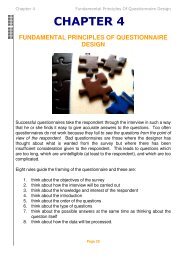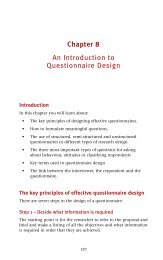The growing business handbook : inspiration and advice ... - Sparkler
The growing business handbook : inspiration and advice ... - Sparkler
The growing business handbook : inspiration and advice ... - Sparkler
You also want an ePaper? Increase the reach of your titles
YUMPU automatically turns print PDFs into web optimized ePapers that Google loves.
240 Structures for growth<br />
relatives on the payroll, excessive travel <strong>and</strong> entertainment costs, <strong>and</strong> remuneration<br />
that exceeds accepted market norms. Although a purchaser might be persuaded that<br />
these costs should be added back to determine the company’s underlying profit, the<br />
argument is always stronger if the <strong>business</strong> can be run for a period with these costs<br />
removed.<br />
Every other element of the company’s cost base should be also scrutinized. If your<br />
<strong>business</strong> will attract a multiple of say eight times earnings, every £1 of cost savings<br />
achieves an eight-fold return in the form of a higher purchase price.<br />
It is not just the quantum of costs that should be reviewed but also their impact.<br />
For example, seek to ensure that expenditure on advertising, <strong>business</strong> development<br />
<strong>and</strong> R&D is designed to produce shorter-term results to help achieve a higher<br />
valuation, rather than long-term results that may not.<br />
Review of assets<br />
When a <strong>business</strong> has assets that may not be required or fully valued by a purchaser<br />
(such as surplus property or investments) removal before a sale commences is<br />
recommended.<br />
In addition, in the lead-up to a sale, working capital should be reduced to the<br />
minimum level required to run the <strong>business</strong>. Policies concerning stock-holding levels,<br />
debtors <strong>and</strong> creditors should therefore be reviewed at an early stage to ensure that<br />
there is no ‘fat’ in working capital. If the company is sold with excess inventory levels<br />
or, owing to poor credit collection, excess levels of debtors, the vendor is, in effect,<br />
gifting the excess working capital to the purchaser. Any surplus working capital<br />
should be eliminated well in advance of a sale <strong>and</strong> the resultant cash proceeds either<br />
stripped out of the company or, preferably, added to the purchase price.<br />
Any hidden or undervalued assets of the <strong>business</strong> should also be identified. If the<br />
value of property assets is understated in the company’s balance sheet relative to their<br />
market value, they should be re-valued independently prior to sale.<br />
If the company owns the property or properties from which the <strong>business</strong> is<br />
conducted, a higher overall valuation can be achieved by either selling the property to<br />
an institutional property investor prior to the sale <strong>and</strong> leasing it back or acquiring the<br />
property from the company at the time of the sale <strong>and</strong> leasing it back to the new<br />
owner.<br />
Tax review<br />
All PAYE, VAT <strong>and</strong> corporate tax matters should be up-to-date <strong>and</strong> tax computations<br />
agreed with the Inl<strong>and</strong> Revenue. Any tax losses available to be carried forward, or<br />
corporation tax benefits from an Enterprise Management Incentive Scheme, should<br />
be identified so that value can be obtained for them from a purchaser.<br />
Pension schemes<br />
Final salary schemes can be very problematic in the context of a sale owing to the<br />
associated valuation issues. Subject to any regulatory constraints <strong>and</strong> the rules








